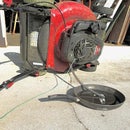Introduction: Really Good Pusher Stick
This is my version of a pusher stick in a Woodsmith video with several adaptations I made. It keeps hands well away from the saw blade. The handle can be removed and attached from the other side when the first side has become chewed up by saw cuts. All parts are individually replaceable.
Materials
- 2 x 4 (I used a really ugly 2 x 4 because I am entering this in the Reclaimed Wood contest.)
- Broomstick or large dowel
- 1/4 inch threaded rod
- Wing nuts
- Drywall screw
Tools
- Table saw
- Crosscut handsaw
- Drill
- Spade bit
- Twist drills
- Needle nose pleirs
Step 1: Cut 2 X 4
Cut a piece of 2 x 4 about 14 inches long.
Step 2: Make a Notch in Both Edges
The Woodsmith version of this had one working edge, and that edge was flat. I wanted an inverted "V" in both edges so I can use the pusher to push the work down and push it toward the saw's fence, too.
Mark the center of the edge. (The tool shown in the first photo is a metal version of the wood version I did for this Instructable.)
Set the saw's blade to 45 degrees and adjust the blade height so the top of the blade is at the mid-point mark. Set the fence so a "V" piece is removed, but leave enough flat area, too. (I removed a little more than I wanted and used a hand plane on the flat area to make the "V" smaller and the flats wider.)
The third photo shows how one of these pusher sticks keeps the work against the fence.
Step 3: Drill a Hole
Drill a hole positioned as shown. A wing nut will be inside this hole to secure the handle. This hole can also be used to hang the pusher stick on a wall.
Step 4: Mark 45 Degree Lines
The 2 x 4 will need notches for mounting the handle. The 45 degree lines in the first photo shows the location of holes for 1/4 inch threaded rod.
See the second and third photos. A handsaw is easier to use than a power saw, and there is less likelihood that a cut will go too deep. Mark and saw for cutting notches as shown.
Step 5: Holes for the Handle
A broomstick will be used for the handle. There will be a threaded rod through the center of the handle and into the 2 x 4. Drill at a right angle to the side of each notch nearer to the hole in the 2 x 4. Dry fit the handle piece and determine how long to make it. Cut it to length. Drill a 1/4 inch hole through the handle. (This part was tricky. The handle is longer than my drill bit. I drilled from each end, but the holes did not meet perfectly in the middle. I drove a 3/16 inch rod through to break the hole open in the center. Then I drove a 1/4 inch rod through the hole. I was able to make the holes meet.)
Cut the threaded rod to length. I used a needle nose pliers to hold a wing nut while I threaded the rod into the 2 x 4 and the wing nut. Slide the handle onto the threaded rod. Add another wing nut and tighten.
The Woodsmith version made a handle from a piece of 3/4 inch stock. There was a lot of waste in order to make the wood grain run in a direction that did not diminish the strength of the handle.
Step 6: The End Piece
An end piece makes a lip to keep the pusher from sliding on the work. I ripped some 2 x 4 to a bit more than 1/4 inch in thickness. Cut it about 4 1/2 inches in length.
Mark centers of the end piece and the end of the 2 x 4. Drill both for a drywall screw. Secure the end piece to the 2 x 4 as shown in the second photo. If the end piece is chewed up by saw cuts, loosen the drywall screw a little and flip it end for end. Replace it when both ends are too badly chewed. The Woodsmith version did not allow flipping the end piece, but required replacing it.
Step 7: My Favorite Version
I wanted what is posted here to be a non-welded version for those who do not have welders. My favorite version uses a piece of angle iron welded to a piece of pipe that has had a wedge removed so it could be bent and welded closed to make an angled handle. This steel handle is attached with two screws. It will be easy to move to the other edge or to a new piece of 2 x 4.

Participated in the
Reclaimed Wood Contest 2016











